Introduction
Understanding the current market value of investments is crucial for making informed financial decisions. Whether evaluating a stock portfolio, assessing real estate holdings, or tracking retirement accounts, knowing how to determine and interpret market value helps investors stay ahead. In this article, I will break down the concept, explain how it is calculated, provide real-world examples, and discuss its implications for investment strategies.
What Is the Current Market Value of an Investment?
The current market value (CMV) of an investment is the price at which an asset would sell in an open market. It reflects the latest trading price of securities such as stocks, bonds, mutual funds, or real estate.
Market value differs from book value or purchase price. While book value is based on historical cost accounting, market value is dynamic and changes based on supply and demand. Understanding this distinction helps investors assess their portfolio’s actual worth.
How to Calculate the Current Market Value
CMV is calculated differently depending on the asset type. Below are formulas and examples for various investments.
1. Stocks and Equities
For publicly traded stocks, CMV is determined by multiplying the latest market price per share by the number of shares owned:
\text{CMV} = \text{Market Price per Share} \times \text{Number of Shares}Example: If I own 200 shares of Apple Inc. (AAPL), and its current price is $180 per share:
\text{CMV} = 180 \times 200 = 36,000Thus, the total value of my Apple stock is $36,000.
2. Bonds
Bond market value depends on interest rate fluctuations and credit risk. The formula for bond pricing is:
\text{CMV} = \sum \frac{C}{(1+r)^t} + \frac{F}{(1+r)^T}where:
- C = periodic coupon payment
- r = market interest rate per period
- F = face value of the bond
- t = time periods until maturity
3. Mutual Funds and ETFs
The value of mutual funds and ETFs is determined by their Net Asset Value (NAV):
\text{CMV} = \text{NAV} \times \text{Number of Units Owned}4. Real Estate
Real estate CMV is influenced by location, property condition, and market trends. A common valuation method is Comparative Market Analysis (CMA), which assesses recent sales of similar properties in the area.
5. Cryptocurrency
For crypto investments, CMV is calculated similarly to stocks:
\text{CMV} = \text{Current Price per Coin} \times \text{Number of Coins Held}Factors Affecting Current Market Value
Several factors influence the CMV of an asset:
- Supply and Demand – Higher demand increases value, while excess supply decreases it.
- Macroeconomic Conditions – Inflation, interest rates, and economic growth impact asset prices.
- Company Performance – For stocks, earnings reports and financial health are key.
- Market Sentiment – News, investor sentiment, and geopolitical events can drive volatility.
- Liquidity – Easily tradable assets tend to have more stable market values.
Comparison Table: Market Value vs. Book Value
| Factor | Market Value | Book Value |
|---|---|---|
| Definition | Current trading price in an open market | Recorded value on financial statements |
| Fluctuation | Changes frequently | Relatively stable |
| Basis | Market supply & demand | Historical cost |
| Usefulness | More relevant for investment decisions | Useful for accounting & tax purposes |
Why the Current Market Value Matters
- Portfolio Assessment – Helps in evaluating gains or losses.
- Investment Decision-Making – Determines whether to buy, hold, or sell assets.
- Tax Considerations – Affects capital gains tax calculations.
- Estate Planning – Essential for inheritance planning and estate valuation.
Real-World Example: Portfolio Valuation
Let’s say I own the following assets:
| Investment | Units/Shares | Price per Unit ($) | CMV ($) |
|---|---|---|---|
| Apple (AAPL) | 100 | 180 | 18,000 |
| Tesla (TSLA) | 50 | 250 | 12,500 |
| S&P 500 ETF | 20 | 450 | 9,000 |
| Bitcoin (BTC) | 1.5 | 40,000 | 60,000 |
| Total | – | – | 99,500 |
My portfolio’s total CMV is $99,500.
Conclusion
Understanding the current market value of investments is vital for financial decision-making. It provides real-time insights into an asset’s worth, helping investors manage risk, plan taxes, and optimize portfolios. By staying informed about market trends and economic factors, I can make more confident investment choices. Whether managing stocks, bonds, real estate, or crypto, tracking CMV ensures I stay ahead in the financial landscape.




